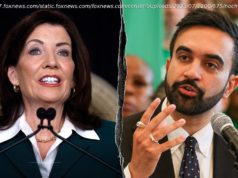‚The whole (birther) thing was crazy and mean-spirited, of course, its underlying bigotry and xenophobia hardly concealed. But it was also dangerous‘
As Michelle Obama’s highly anticipated memoir “Becoming” arrives, it’s clear that the former first lady is occupying a space in the culture beyond politics. With an arena book tour featuring A-list special guests, she seems to exist in the middle ground between two icons she calls friends, Oprah Winfrey and Beyoncé Knowles-Carter. Her approach is short of Winfrey’s full-on confessional style but goes further than the guarded intimacy of Knowles-Carter’s art and performances.
Her book walks a similar line. It’s revealing, right down to the glossy cover photo in a casual white top – one shoulder exposed, eyes bright. (Spoiler: It’s not the kind of shirt a soon-to-be political candidate wears.) But Obama, who was famously guarded as first lady, still values her privacy – even as she offers frank opinions about Donald Trump and discloses past fertility struggles.
I’m thrilled to share with all of you the cover for BECOMING. The process of writing this book has been so personally meaningful and illuminating for me. As I prepare to share BECOMING this fall, I hope you’ll also think about your own story, and trust that it will help you become whoever you aspire to be. Your story is what you have, what you will always have. It is something to own. #BECOMING
A post shared by Michelle Obama (@michelleobama) on May 24,2018 at 6:33am PDT
“I don’t think anybody will be necessarily prepared to read a memoir like this – especially coming from a first lady,” said Shonda Rhimes, the television producer, who read an advance copy of Obama’s book.
The first-lady memoir is a rite of passage, but Obama’s is different by virtue of her very identity. “Becoming” takes her historic status as the first black woman to serve as first lady and melds it deftly into the American narrative. She writes of the common aspects of her story and – as the only White House resident to count an enslaved great-great-grandfather as an ancestor – of its singular sweep.
In the 426-page book, Obama lays out her complicated relationship with the political world that made her famous. But her memoir is not a Washington read full of gossip and political score-settling – though she does lay bare her deep, quaking disdain for Trump, who she believes put her family’s safety at risk with his vehement promotion of the false birther conspiracy theory.
“The whole (birther) thing was crazy and mean-spirited, of course, its underlying bigotry and xenophobia hardly concealed. But it was also dangerous, deliberately meant to stir up the wingnuts and kooks,” she writes. “What if someone with an unstable mind loaded a gun and drove to Washington? What if that person went looking for our girls? Donald Trump, with his loud and reckless innuendos, was putting my family’s safety at risk. And for this I’d never forgive him.”
It is the most direct and personal language she’s used about Trump.
The Washington Post obtained an early copy of Obama’s book, which will be released Tuesday. Even those who have followed Obama’s life closely in the decade and a half since her husband was a relatively unknown Illinois politician will come away with fresh understanding of how she sees the world and the people and experiences that shaped her.
She divides the memoir into three parts: Becoming Me, Becoming Us, Becoming More. The first section is a deep, often sociological exploration of Chicago and the people and institutions there. Its textured discussion of gentrification, public education, race and class are reminders that Obama majored in sociology and minored in African-American studies at Princeton University.
The second section, Becoming Us, is a romp through her romance with Barack Obama, starting a family with him and her search for work that she loved. It begins with words that have never before been written by a first lady about her man: “As soon as I allowed myself to feel anything for Barack, the feelings came rushing – a toppling blast of lust, gratitude, fulfillment, wonder.”
The third section, Becoming More, traverses their life as public figures. It contains her own view of her legacy and accomplishments as first lady and what it felt like to live under the intense scrutiny she faced. As she campaigned for her husband’s reelection in 2012, she writes that she felt “haunted” by the ways she’d been criticized and by people who had made assumptions about her based on the color of her skin.
She thought then about what she owed and to whom: “I carried a history with me, and it wasn’t that of presidents or first ladies. I’d never related to the story of John Quincy Adams the way I did to that of Sojourner Truth.”
From the preface, Obama promises a story that covers the full contour of her life – growing up in a “cramped apartment on the South Side of Chicago” to living in “a place with more stairs that I can count.” From “being held up as the most powerful woman in the world” to being “taken down as an ‘angry black woman.’ ”
She returns to a discussion of what she calls the angry black woman “trap” that dogged her: “I was female, black and strong, which to certain people . translated only to ‘angry.’ It was another damaging cliche, one that’s been forever used to sweep minority women to the perimeter of every room . .. I was now starting to actually feel a bit angry, which then made me feel worse, as if I were fulfilling some prophecy laid out for me by the haters.”
Obama is most revelatory when writing about her 30s; how she continued to grieve the deaths of a dear friend and her beloved father; how she dealt with her own version of the chewed-over “Can I have it all?” dilemma working mothers face.
She also shares intimate details for the first time, for instance, that she and her husband had trouble getting pregnant, suffered a miscarriage, and that both daughters were conceived through in vitro fertilization. And that she did a great deal of this while her husband was away serving in the state legislature, leaving her to administer the shots that are a part of that process herself.
Inevitably, her memoir will be compared to those of other first ladies. Her focus on owning your own unique story sets her book apart, but it is similar to Laura Bush’s in one respect. Both women most deeply excavate the part of their life before the presidency enters.
“I was very surprised, pleasantly surprised, by the level of candor and the level at which she opened herself up,” said Rhimes, who has read memoirs by other first ladies and created a fictional one on her show “Scandal.” “I love the honesty and the humor and the beauty with which she addressed the romance of her marriage and the tribulations of her marriage and motherhood, and all of those things that we as women all can relate to.”
Obama, for example, describes a lunchtime bliss familiar to many working women raising small children. There were times she left her desk, picked up a fast-food lunch after running errands and sat in her car alone with the radio playing, “overcome with relief, impressed with my efficiency.”
The White House years are the period of time on which Obama has had the least time to reflect. There are moments she speeds through and others where she recites her methodical approach to planning her first-lady programs, intentionally focusing her “Let’s Move” initiative on children so as to avoid being accused of overreach. She contends that the firewall between the Office of the First Lady and West Wing was solid – mentioning that her husband called her to the Oval Office only once. That was after the tragic Newtown shootings. They both mourned, and she links the gun violence there to the urban shootings in her hometown and expresses her disbelief regarding the congressional failure to pass gun-control legislature.
Start
United States
USA — mix Michelle Obama will never forgive Donald Trump for 'putting my family's safety...






